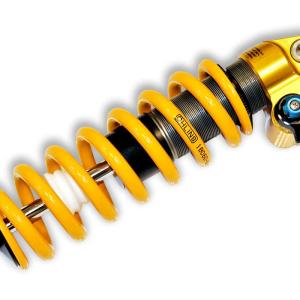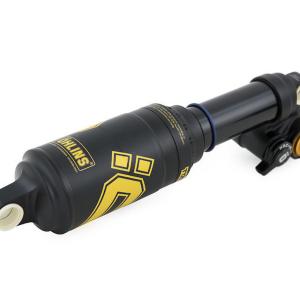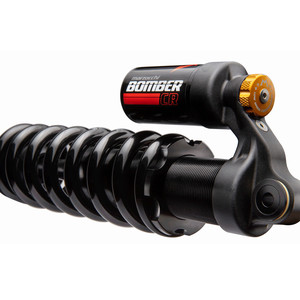EXT Arma HBC Rear Shock
| Where To Buy | |||
|---|---|---|---|
Free shipping on orders over $50 (continental U.S. only).
International shipping available. Some exclusions apply. |
|||
Free shipping on orders over $50 (continental U.S. only).
International shipping available. Some exclusions apply. |
|||

The Italian word “Arma” translates to “Weapon.” If you currently don’t know anything about this company or piece of suspension, that's at least a pretty good starting point. Extreme Racing Shox, better known as EXT, is an Italian brand that has been immersed in the world of racing for 55 years. They have been helping make rally, F1, Le Mans, and pretty much anything that needs to go fast, do so under precise control with their unique valving technologies and future-minded approach to product development. In 2014, EXT decided to take their decades of experience in motorsports and bring it to the world of mountain biking. In 2017, Vital rode an Arma HBC-equipped test bike in Val di Sole, and at the end of the afternoon our interest was piqued – something special was happening, but we needed more time to really get to the bottom of things.

EXT Arma HBC Features
- Gas monotube design
- External low-speed rebound (8 clicks), low-speed compression (12 clicks), high-speed compression (14 clicks), and hydraulic bottom-out control adjustments (HBC, 8 clicks)
- Unique rebound system to separate bump and rebound oil flow
- 29mm diameter high-flow main piston / 24mm valve piston / 28mm reservoir floating piston
- CNC machined in 7075 T6 alloy and titanium
- Special seals and proprietary steel chrome shaft coating to reduce friction
- Low reservoir pressure (40psi) for improved sensitivity
- Low hysteresis for high dynamic response
- Service suggested at 50 hours (race) or 100 hours (general use)
- Weight: 790g (claimed, 241x76mm shock with 325-lb/in spring)
- MSRP: €799.00 (~ $930 USD)
- Two-year warranty
Standard Sizes
- 220x70mm
- 241x76mm
- 267x89mm
- Custom sizing available
EXT Spring
- Super Steel Spring (proprietary lightweight design)
- Extreme Linear Ratio
- Hard epoxy coating
- Internal diameter of 38.5mm
- Lengths: 117, 140, 175mm
- Shock stroke compatibility range: 50mm to 89mm
- Lightest steel spring on the market (claimed)
- Developed through motorsports programs
- Next generation after the Super Alloy Racing springs
- 25-pounds spring rate increments
- Adaptable for all types of coil dampers in the market
- Life duration of over 500,000 cycles
EXT Spacers
- Spacers allow the spring to fit any shock on the market from 200x57 to 267x89mm
- Available for FOX, RockShox, Marzocchi, CaneCreek, BOS, DVO, Ohlins and more
Setup
We received our Arma EXT shock in Queenstown, New Zealand during one of the driest summers the Wakatipu Basin had seen in several years. The bike park was in dire need of some TLC… the perfect conditions for a shakedown of a hydraulic damper. Reading the instruction manual (yes, we did that), it was clear that the adjustments were easy to understand. At the factory settings it could be ridden out of the box. We tinkered slightly, giving the shock the following settings on a Zerode G27.5 downhill test bike.The detents are easy to feel with a subtle "click".
Initial settings, maybe huck-approved:
- HBC: 4clicks from closed
- High-Speed Compression: 9 clicks from closed
- Low-Speed Compression: 12 clicks from closed
- Rebound: Closed
Both a 475 and 500-lb/in coil spring came with the shock. EXT provides two springs with every shock sold, which are based on your riding style and bike (which you specify when purchasing the shock). The Super Steel Spring is the second iteration of the famed Special Alloy Racing Spring, and is made of a special alloy that is comparable in weight to titanium but less expensive.


We started with the 475 spring and left it on for the New Zealand portion of our testing. Being that Skyline Bike Park is steep and rough, having the bike sag a little more is helpful to level the bike and keep rider weight in a more neutral-rearward position. The high-speed and low-speed clicks make notable changes in the shock’s behavior and feel, and tuning is simplified because of this. It only takes two clicks to feel a big change, with one click providing that fine touch. We ran the rebound as slow as possible, as the shock is tuned to be ridden really fast – it’s specifically race equipment, so the rebound tune is a bit faster overall than other shocks on the market… basically you can’t turn it into molasses. The valving on the rebound also separates rider-influenced rebound and bump-related rebound, effectively internally-designed high- and low-speed rebound, with a single exterior adjuster.

When using aftermarket suspension it is crucial to understand that there often isn’t really a "base tune," though it is designed to be a custom piece of equipment specific to the intended user and application. The springs we were given were 50 and 75-lbs/in lighter than the spring we’d been using on the previous shock. This is no accident, though, thanks to the EXT’s unique Hydraulic Bottom-out Control damper – the “HBC” in the EXT Arma HBC. This allows a lighter spring to be run in favor of improved small-bump absorption, as HBC kicks in during the last 15% of the stroke and ramps up the shock as if it were a more progressive suspension design or air shock.
HBC was an exceptionally helpful feature for our needs, as the Zerode bike we used for testing doesn't have a ton of progression. By the end of our test time we were running the HBC setting fully closed, achieving a ride characteristic that was almost too encouraging. With a rearward wheel path and what felt like bottomless travel, hucking become even more commonplace.


Testing in New Zealand
The Arma worked so flawlessly it became something we didn't have to think about. After a few laps and some minor tweaks, it did its job and we were able to focus on riding. Using flat pedals (because we win imaginary medals), a shock’s ability to eat high-frequency chatter and g-outs alike is a crucial point of contention. After our first "fast" run down the hill on the first day of riding we were sort of stumped about why something felt weird. Sitting in the gondola queue mulling it over, we realized that our feet had remained perfectly planted on the pedals with no jostling or fidgeting about. The Arma was working so well, it felt weird! After that all bets were off, and we proceeded to hammer everything in sight, including huge holes, loose corners, and lots of heavy hits. The feeling of not having significant feedback from the rear suspension was such a treat, especially during one of the roughest mid-summers in recent years.

This theme continued through the remainder of the New Zealand summer, with pace getting higher and higher and our grin getting wider and wider. Finding new lines and hitting old ones harder, the confidence the Arma shock provided was something special. It was especially interesting when hitting really big compressions/holes/things in the trail as there wasn’t any bucking or weird chassis movement. The rebound circuit is something to behold, it keeps the bike under an almost abnormal amount of control, casing a 45-foot table because we were tired was no longer the scariest part of our day. We hit g-outs and bump-jumped some sizeable objects, and the bike just kept rolling forward with no up/down/sideways kick. There was also no squirming in corners – just pure traction and exit speed – another notable attribute the bike gained with the addition of the shock.
Something we liked (but took a moment to adjust to) was the slight whisper the shock emits as it compresses, akin to a turbo blow-off valve. It fades into background noise, but on the first run of the day or after lunch when you’re warming back into “ride mode,” the soft hiss of the shock eating up the rough is a fun reminder that things are under control and it’s time to get sendy!



Testing Continued, Back Home
When we returned back to New Hampshire, the race season was right about to start. With new changes to categories of the Eastern States Cup (they added a Pro Open category), we saw an opportunity to put the Arma through some new paces at our old stomping grounds, Plattekill Mountain – East Coast hardcore at its finest. Few places in the world compare to how steep Skyline Bike Park in Queenstown is, so we swapped up to the 500-lb/in spring to help the bike sit up a little more on the less-steep home pitch, and we also closed down the low-speed compression two clicks. No matter how much we tell ourselves, “We’re just gonna chill,” when there is a race plate tied onto the front of the bike things are getting turned to 11.

A Saturday of excited riding and mock race runs reminded us why we put the big spring on, and also how interesting the Arma was to ride on familiar tracks and terrain. Maybe we are just better riders (having not raced since 2015), but we like to think it was also thanks to the shock. Holding tight lines in the roots and shale, white knuckling rock gardens, and over-shooting short gaps into blown-out braking zones always felt manageable and under control from a suspension standpoint… the pilot, maybe not always. Sections that would have given us a moment of pause were passé and executing consistent runs with accurate line choice almost felt easy. The bike stayed predictable even under changing track conditions, and that was really impressive. Due to a weather-related power outage on Sunday, the riding was consolidated into a single blind race run down a now muddy and wet track (practice was canceled). The race organizer understood it wasn’t ideal for a lot of people and offered a refund to those who chose to not race. We opted for the latter option and decided to hang out and talk bike tech over coffee in the pits rather than take silly risks so early in the season.


At home, after the race, we still wanted to try and find a more refined setting for the summer ahead (more racing!?), as the terrain in Queenstown and the Northeast US are nothing alike. A half-dozen laps on our local test track, a lot of GoPro footage, some settings consulting, and a lot of bug spray later, we have a shock that is truly inspiring. The Arma has us pushing the upper limits of control on a trail that now looks less-than-fresh after shredding it to bits and laughing the whole way down.

At the end of the test, the level with which we are impressed with the Arma is still 100%. From the first day we climbed aboard the exquisite-looking damper to eight months and some wild riding later, it only ever made us smile and try to ride harder.
Final settings, huck-approved:
- HBC: Closed
- High-speed compression: 9 clicks from closed
- Low-speed compression: 5 clicks from closed
- Rebound: Closed
The Zerode G27.5 uses a high-leverage single-pivot suspension design with 6-7% progression overall. Because of this, we closed the HBC to aid in giving it a more progressive feel. The low-speed compression was also cranked down a fair amount to aid the suspension in sitting up in its travel. High-speed compression was to taste, and we were able to run it a little more open thanks to the HBC. Rebound was also to taste, and perhaps a little slower than some might like, but due to the wheel path of the bike it feels more stable with a slightly slower return – we also plow straight down the trail a bit off the back, so a “playful” bike isn’t what we were trying to achieve. The heavier 500-lb/in spring is also the weight we’ve found to be the most suited for our size and style of riding.
The shock was paired with a FOX 40 RC2 fork:
- High-speed compression: 15 clicks from closed
- Low-speed compression: 10 clicks from closed
- Rebound: 12 clicks from closed
- Air spring: 77psi with one spacer at the bottom (older metal spacers on the air seal/shaft system)



What's The Bottom Line?
If you are really picky about how your bike feels, can sense each click, and like the semi-factory aspect of aftermarket suspension, this is your new favorite shock – especially if you ride flat pedals. The beautifully CNC’d pieces, refined industrial looks, and an insanely cool pedigree make the EXT Arma HBC shock standout. The shock works like a dream, doing everything you'd expect and then some. It also adds some great “bling” factor to any bike.
For those who race, want a bike-tailored shock, and make frequent adjustments to try and eke out every last tenth of a second, this will be a worthy investment. It’s also a great option for anyone who likes the performance of a coil shock but have a downhill bike with a less progressive suspension curve. The price is no doubt on the higher side, but it is race-focused performance equipment.
Visit www.extremeshox.com for more details.
About The Reviewer
Zach Faulkner - Age: 27 // Years Riding: 17 // Height: 5'10" (1.78m) // Weight: 205-pounds (93.0kg)
Also known as #MTBJesus, Zach looks like a circus bear on a bicycle. His riding style has been compared to a landslide, replete with sounds of destruction and debris chasing his rear wheel down the hill. He rides flat pedals because they win medals, and he’s fond of quad-piston brakes on all of his bikes. His zeal for riding is life-long, having been astride a bike since before he was forming memories. Bikes kept him in the woods and out of trouble through his teenage years, and after more than a decade of racing DH, can now be found lying in the dirt next to race courses around the World behind a camera, writing at his computer late into the night, or out on the trail thundering through the woods.
Specifications
www.extremeshox.com (Europe) or www.extusa.bike (USA)
| Where To Buy | |||
|---|---|---|---|
Free shipping on orders over $50 (continental U.S. only).
International shipping available. Some exclusions apply. |
|||
Free shipping on orders over $50 (continental U.S. only).
International shipping available. Some exclusions apply. |
|||





























24 comments
Post a reply to: Tested: EXT's Rally-Inspired Arma HBC Shock